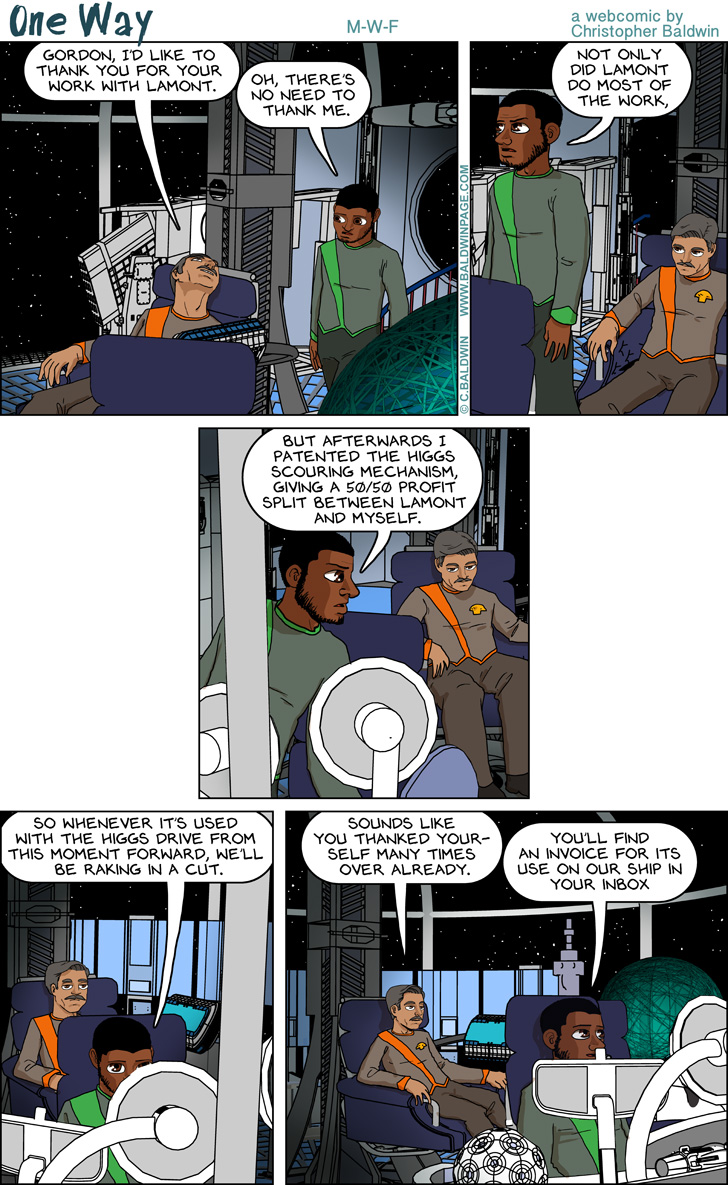
Had a nice weekend. I made cookies on Friday, gone by Saturday. Trying to plan out the next chapter of the novel, but it’s stumping me a bit. Made pancakes, made burritos, made stew. Rode my bike to play racquetball against myself (while listening to Harry and the Potters, which is what i always listen to while playing racquetball).
Worked more on the “Siblings” painting. I’m liking how it’s coming out.


















The problem with Gordon’s plan is that their employers will actually own the patent and Gordon and Lamont will only get whatever compensation they contracted for, if any. It will likely be considered work-for-hire. As it’s the company’s IP, the invoice would be the company billing itself, and invalid. They might get commissions if they license the tech to the aliens, assuming the aliens don’t already have it. Mutual tech trade and licensing is probably outlined in first contact law even though contact hasn’t been made yet.
They better have first contact law established. It would be awkward if no one planned beyond the first date. “So, uh, what do you want to do?” #Do not know we. What doing want you?#
I have this weird feeling that Lamont engineered this whole episode to distract everyone and especially Gordon from looking further at that alien message. First the beer, now this.
If we assume that the higher-ups sent the ship under false pretenses it would make sense that they also sent someone amongst the crew to make sure nobody finds out.
I thought they didn’t have any FTL way to communicate with Earth? It doesn’t seem possible to patent anything if you cannot contact the patent office.
If it’s considered work-for-hire or not would depend on their contract. Employer-takes-all is common, but not the only model.
Red Hat’s employees contribute to free software projects in their own capacity (on paid time), not on behalf of the company, and own the copyright to their own contributions.
Many universities (not in the USA) consider the rights to doctorate research results as belonging to the people who did the research and encourage them to found their own spin-off businesses based on what they learned.
If the patent is seen as a money saving innovation then they could get a % of the savings as a bonus.
And if they live to see the money….. 😉
Nice to see that patents won’t take years to complete… IN THE FUTURE!!!
@Clack, the paper (so to speak) that describes the process could be locked in the computer with a cipher key that would include the date of the discovery/encipherment. Such a document could be considered to be evidence of “first to publish” for purposes of academia and/or patent process. Given the amount of research being done and the number of papers published/filed, etc. at this point in the future, society would have to come up with something like that in order to solve these timing problems.
I remember back in college how one professor was crushed because he had spent years researching something, had come up with an original discovery, wrote it up, submitted it to a journal, and had to contend with being in second place because a competitor made the same discovery AFTER my professor, but got published BEFORE he did by 3 weeks.
Even if they are independent contractors I’d think the owner of that ship would get at least 50% of that dividend. Maybe more.
Everybody’s right, sort of. Maybe. If Gordon and Lamont are regular full-time staff employees, it’s possible that the copyright for group work that is part of their normal job is owned by their employer. But they’d know about it. If making scouring mechanisms or whatever or inventing is not tied to their regular responsibilities (harder to argue than, say, taking pics of the stars), then Gordon and Lamont retain ownership. If they have an employer paying for space exploration innovation in general, then tough nuts. Creatives take note – this is why it’s in your best interest to pay attention to your job description and know your rights.
Work-for-hire is limited to certain types of work and has to be agreed upon by both parties in the hiring contract to be valid. Or sign some sort of memo. Somewhere the magic words “work for hire” must be used.
The 9 types of work:
1. A contribution to a collective work (software usually falls here)
2. A part of a movie or other audiovisual work
3. A translation
4. A supplementary work
5. A compilation
6. An instructional text
7. A test
8. Answer material for a test
9. An atlas
“If the work is not one of these and the author is not an employee, work for hire does not apply.” (p59, Content Rights for Creative Professionals : copyrights and trademarks in a digital age / Arnold P. Lutzker. –2nd ed.) (GET IT)
ps – I’m not a lawyer, yo, so don’t misconstrue this as legal advice, except for the “know your rights” part.
🙂